Cocoa butter is a hard vegetable fat with a distinct, chocolate-y aroma that is extracted from the cocoa bean. A major ingredient in chocolate, cocoa butter is commonly used in bath and body products due to its skin-loving properties. Because of its hard texture and warm smell, cocoa butter makes a fabulous addition to soap, lip products, body butters and more.
Cocoa butter is available in two varieties: deodorized cocoa butter and non-deodorized. Naturally, cocoa butter has a deep eggshell color and a warm, chocolate smell. Deodorized cocoa butter is deodorized via steam injected into the melted cocoa butter to “drive off” the components which contribute to the odor. The product is then treated with diatomaceous earth (clays) which remove the color agents. The result is a butter that is lighter in smell and color. When deciding between the two, consider how your project will be affected by the color and smell of cocoa butter. Because of its naturally chocolatey scent, cocoa butter can hide some delicate fragrances, so keep that in mind when working with more faint fragrances.
Cocoa butter has a high melting point of approximately 95.0–97.7 °F which makes it brittle at room temperature. When melting cocoa butter for beauty recipes, it’s best to temper it (as you do with chocolate) to prevent crystallization. Cocoa butter tends to crystallize due to its fatty acid profile. Simply put, the fats in cocoa butter melt and solidify at different temperatures, which can lead to fatty acids forming large clumps. To read more about why cocoa butter crystallizes, click here. Tempering the cocoa butter helps ensure your final product (lip butters in particular) is smooth, not grainy. However, in cold process soap, no tempering is needed.
In cold process soap, cocoa butter adds firmness and moisture to the bar. We recommend using cocoa butter at 15% or less; any higher may lead to cracking in the final product. Both palm-free recipes, the Queen of Hearts and Layered Lilac Loofah Cold Process soaps contain cocoa butter to give the bars hardness. In the Espresso Shot Cold Process and Natural Colorant Taiwan Swirl tutorials, cocoa butter is used for moisture and firming abilities.
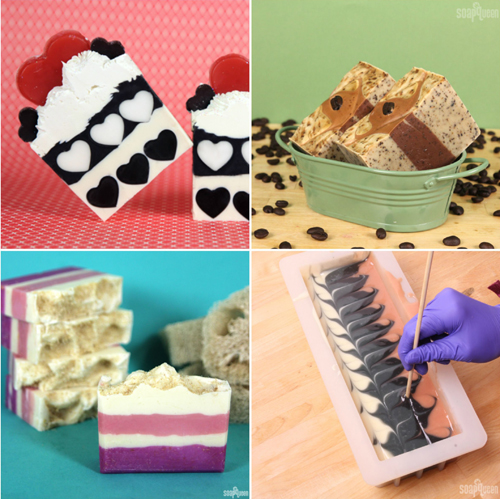 Top row: Queen of Hearts Cold Process, Espresso Shot Cold Process
Top row: Queen of Hearts Cold Process, Espresso Shot Cold Process
Bottom row: Layered Lilac Loofah Cold Process, Natural Colorant Taiwan Swirl Cold Process
Due to its moisturizing abilities, cocoa butter makes a great addition to leave-on body products. Because of its hard texture, cocoa butter is perfect for creating thick-textured body butters and creams. In the Moisturizing Heel Butter, cocoa butter is used to help create a firm yet spreadable texture that’s perfect for cracked, dry heels. Cocoa butter is also used in the Bramble Baby Belly Butter and Everything Balm, two leave-on creams that are both hydrating.
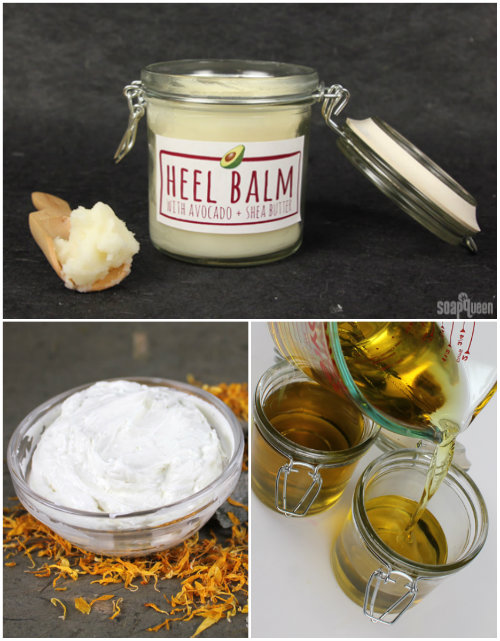 Top Row: Moisturizing Heel Butter
Top Row: Moisturizing Heel Butter
Bottom Row: Bramble Baby Belly Butter, Everything Balm
Looking for even more leave-on body products featuring cocoa butter? We’ve got you covered! The Mango Avocado Balmy Salve uses a combination of both hard butters like cocoa butter, and luxurious soft oils such as jojoba oil to create a creamy and skin-loving product. The Soothing Lavender Breast Balm has a similar texture to petroleum jelly, and is scented with soothing Hungarian Lavender Essential Oil. In the Lotion Bar Love tutorial, micas and Summer Fling Fragrance Oil are used to create a lotion bar that’s both colorful and fruity.
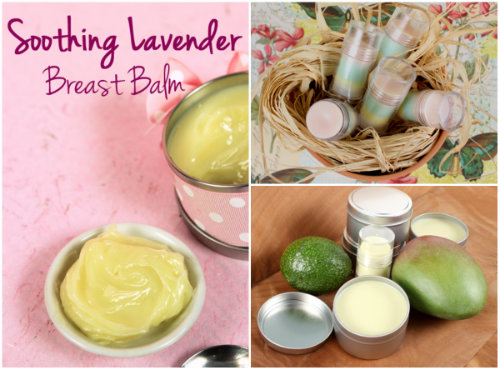 Left to right, clockwise: Soothing Lavender Breast Balm, Lotion Bar Love, Mango Avocado Balmy Salve
Left to right, clockwise: Soothing Lavender Breast Balm, Lotion Bar Love, Mango Avocado Balmy Salve
If lips are feeling dry and cracked, cocoa butter gives lip balms a firm and luxurious texture. In the Vanilla Latte Lip Balm tutorial, cocoa butter and coffee butter come together to create a silky texture and naturally delicious smelling lip product. It smells like a mocha!
What is your favorite way to use cocoa butter? Personally, I love using it in my cold process soap recipes for firmness and moisturizing abilities!
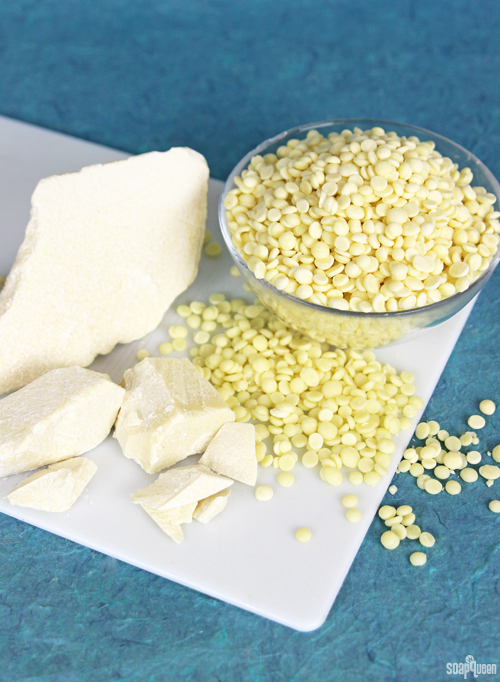
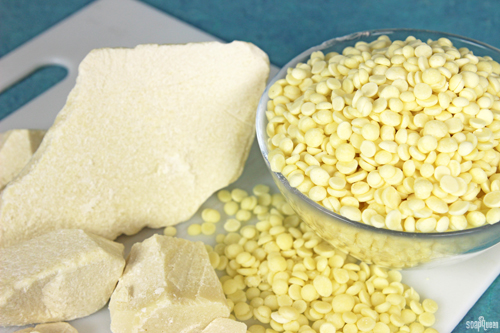
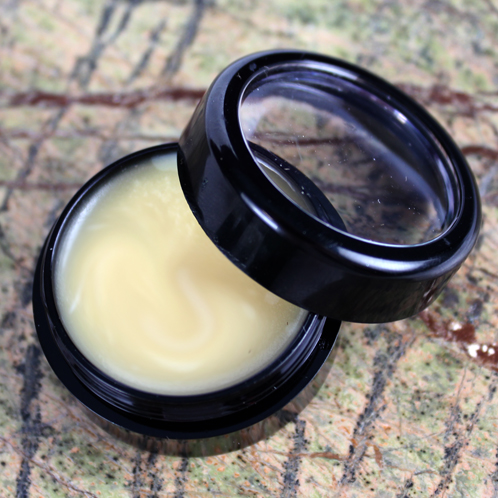
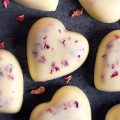

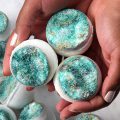
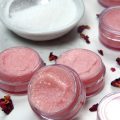
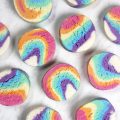
Hi, I’ve often heard that cocoa butter should be used at night, because while it’s on your skin when exposed to sunlight, it tends to have a tanning effect. This worries me about using it in lip balms and other lip products. Does this mean that adding cocoa butter to my lip products will cause my lips to turn dark? I hope you respond soon,as this is a major concern of mine.
Hi Vinita!
I’m not entirely sure if cocoa butter has tanning effects! From what I understand, manufacturers often add cocoa butter to tanning products to help moisturize the skin. It also has a high melting point, making it nice for products exposed to warm summer temperatures. I have personally used it in balms and not noticed any sunburning on the lips. To be extra careful, I would recommend using a lip balm with an SPF on top to protect your lips. 🙂
-Kelsey with Bramble Berry
Is there any place to buy fractionated cocoa butter? Also, I was wondering if I do this will it make my lip balm more oily than if I just melted the cocoa butter with the rest of the ingredients in the balm and put in into tubes?
Thank you so much for the information! 😀
already tempered* not fractionated. Unless they are the same thing?
Hi Kya!
I’m not sure of a place that sells tempered or fractionated cocoa butter. Sorry about that. You can temper cocoa butter at home though! Learn how in this post: https://www.soapqueen.com/bath-and-body-tutorials/tips-and-tricks/soaping-in-the-summer-heat/
Tempering won’t affect the final feeling of the cocoa butter, except to prevent that graininess. So in balm it will still add a firm, buttery feeling. 🙂
Learn more about making lip balm here: https://www.soapqueen.com/bath-and-body-tutorials/lip-products/how-to-create-lip-product-recipes/
-Kelsey with Bramble Berry
Hello (:
You recommend using this at 15% or less in soap–I assume that means 15% of the total formula, right? Not 15% of the base oils?
Also… If you plan on superfatting your soap should you lower the amount of cocoa butter? Is cocoa butter considered a superfat? I’m planning on using jojoba oil to superfat my soap around 5%, but I also want to incorporate cocoa butter into my recipe. How would you recommend I balance the two?
Thanks (:
Hi Daniel!
The 15% is 15% of the total weight of the oils, not the total formula. So, you want the cocoa butter to be 15% or less of the oil weight. Read more about formulating cold process recipes here: http://www.soapqueen.com/bath-and-body-tutorials/tips-and-tricks/formulating-cold-process-recipes/
As for the superfat, our Lye Calculator does the work for you! It pulls out a tiny amount of each oil to create the superfat. That means you can calculate your oils to 100%, then select your desired superfat level from the calculator. This post has more information on superfat and is really helpful: http://www.soapqueen.com/bath-and-body-tutorials/cold-process-soap/superfatting-soap-an-explanation-2/
-Kelsey with Bramble Berry
Thank you for the clarification/links (:
You’re welcome!
Hey again,
I’ve read that cocoa butter on it’s own is comedogenic–That’s not true for saponified cocoa butter, right?
This is great thank you! I got a questionably stored batch from a local supplier where it looks like they melted their butters and stored them in plastic containers for purchasing. I’d love to go ahead and temper these and perhaps put them into small molds to make smaller bars. Can I do that? Or does the butter need to be immediately used? If I need to melt the butters again, will it affect them badly?
Thanks!
Hi Natasha!
You’re welcome, glad you enjoy the post! 🙂
Also, you can definitely temper that butter! Butters can be remelted many times without affecting the quality. To temper cocoa butter, we recommend heating to about 100F and holding that for 45-60 minutes. Then, you can pop that in the freezer so it will cool rapidly. Read more about tempering in the Soaping in the Summer Heat post: http://www.soapqueen.com/bath-and-body-tutorials/tips-and-tricks/soaping-in-the-summer-heat/
-Kelsey with Bramble Berry
That’s a relief! Thank you so much!
You’re welcome Natasha! 🙂
-Kelsey with Bramble Berry
Hi! Will tempering work the same with shea butter? Or does this only help with cocoa butter grittiness? Sorry if this was asked already, scanned the comments and didn’t see it! 🙂
Hi Sarah!
Good question. Tempering is great for a wide variety of butters, including shea butter. Butters include various fatty acids, and each acid has different melting and solidifying temperatures. Once the butter begins to cool down from a melted state, the fatty acids will begin to solidify at different temperatures. If the butter cools down slowly, the fatty acids may clump together. These clumps are the graininess that you feel on your skin. To avoid this, melted butters should be cooled quickly to help all the fatty acids solidify at the same time, which prevents them from forming clumps. If your butters arrive liquid or semi-liquid, stir or shake them up to get the fatty acids mixed back up evenly and, pop them in the freezer right away to help them cool quickly and evenly. This works great for coca butter, and other butters such as shea and mango 🙂
-Amanda with Bramble Berry
Wow!! Thank you SO much for the very informative response, Amanda!! 🙂 I am going to whip up a batch of lip balm today and try this out! Thanks!
I purchased a couple of pounds of cocoa butter. I would like to melt it down and make smaller cubes. After reading your article, it appears that tempering it would be best during this process.
What do you think the best method would be for heating the cocoa butter slowly (crock pot on warm or double boiler)? Also, does it affect the tempering to move the liquid cocoa butter to ice cube trays during the cool off period?
Thank you so much for your informative articles!
Hi Toni!
A Crock Pot or double boiler would both work great! The key is to keep the heat around 180F and hold that for 45-60 minutes. Read more in the Soaping in the Summer Heat post: http://www.soapqueen.com/bath-and-body-tutorials/tips-and-tricks/soaping-in-the-summer-heat/
Also, those ice cube trays should be just fine! You want the butter to cool rapidly, so having them in smaller containers should help that. Just make sure to wrap the ice cube trays to protect your butter from the air. 🙂
-Kelsey with Bramble Berry
Should cocoa butter be tempered if it’s used as a superfat after the cook in hot process?
Hi Jane!
You can temper your cocoa butter if you like! Cocoa butter tends to get grainy if it’s heated too much or too quickly. With hot process soaping, the temperature is usually around 160F, and you’re adding it when the soap is cooling down. That is a fairly gentle environment, and shouldn’t cause graininess!
You may want to temper it just to be extra careful though. 🙂
-Kelsey with Bramble Berry
Thank you for your troubleshooting tips! Been making body lotion that turned out bumpy/grainy and needed some direction. I so appreciate the help!
You are so welcome Lauren! Heating cocoa butter gently or tempering it helps prevent that grainy feeling. 🙂
-Kelsey with Bramble Berry
I found this under the Cocoa Butter section on the Brambleberry Website
Note: To avoid crystallization when melting cocoa butter, it is best to temper it. It’s simple to do: raise the temperature on your melting cocoa butter slowly, over 45 minutes. Then, turn the heat off, cover the cocoa butter and let it cool for approximately 10 minutes. Use this method to achieve smoother lotion and lip balms.
Hi Jocelyn!
That is correct! Thanks so much for sharing. 🙂
-Kelsey with Bramble Berry
Cocoa butter: https://www.brambleberry.com/Cocoa-Butter-P3218.aspx
I also would like an answer to Alicia’s question. I have had the same problem with a couple of my lotion bars. Any help would be greatly appreciated. This is the first that I had heard of tempering the cocoa butter and all of the recipes do not explain that either.
Hi Linda!
To temper your cocoa butter, raise the temperature slowly over 45 minutes. Then, turn the heat off, cover the cocoa butter and let it cool for about 10 minutes. After it is tempered, put it in the freezer until it’s completely cool. Then, store it in a cool dark place. That should help prevent those grains. 🙂
-Kelsey with Bramble Berry
Could you please provide some tips on tempering? I make lotion bars that begin with melting beeswax in a double boiler, than I add cocoa butter to the melted beeswax and melt that, then mango butter and melt, and a variety of other oils. I’ve noticed that some of my older bars have gotten grainy, and I believe it has something to do with temperature changes in the room where they are stored during summer/fall. Could that cause graininess? Is that ‘fat bloom’? How can I prevent this? I’d hate to have to throw out a bunch of stock because they are unpleasant to use. I’ve tried melting them down again and remolding, which seemed to help on the surface, but the graininess returns. Any help would be greatly appreciated!
Hi Alicia!
Jocelyn is correct – to temper your cocoa butter, raise the temperature slowly, over 45 minutes. Then, turn the heat off, cover the cocoa butter and let it cool for about 10 minutes.
Also, temperature can definitely affect graininess of the cocoa butter. After your butter is tempered, put it in the fridge or freezer to cool. Then, store it in a cool, dark place until you need to use it. That helps prevent the graininess. Hope that helps!
-Kelsey with Bramble Berry